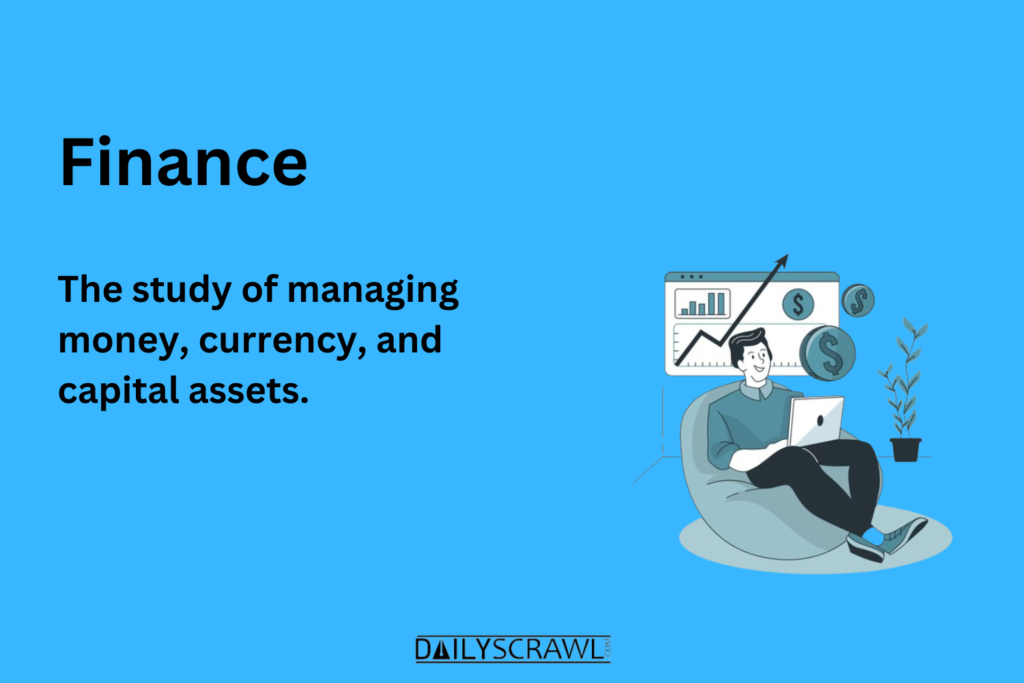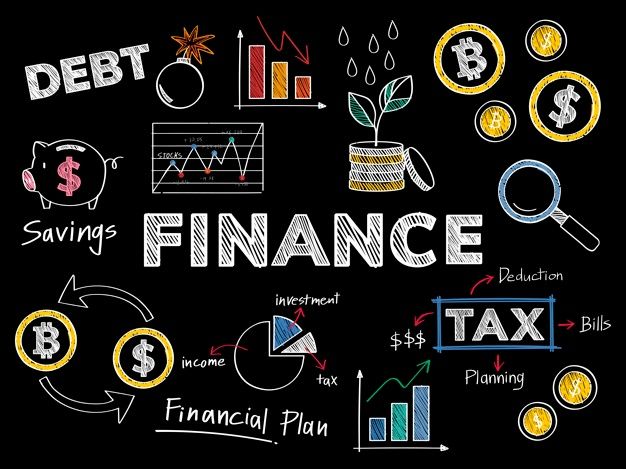In the intricate tapestry of economic systems, finance emerges as a linchpin, influencing and directing the trajectory of modern societies. This comprehensive exploration delves into the essence of finance, tracing its historical evolution, exploring its diverse types, and shedding light on key concepts and careers in this dynamic field. As we embark on this journey, we aim to demystify finance, making its complexities accessible to a broader audience.
What Is Finance?
Finance, at its core, is the strategic management of money. It encompasses a spectrum of activities such as investing, borrowing, budgeting, saving, and lending. Serving as the lifeblood of economic systems, finance facilitates the flow of capital and resources, playing a fundamental role in shaping our world.
Finance can be broadly divided into three categories:
- Public Finance
- Corporate Finance
- Personal Finance
KEY TAKEAWAYS:
- Finance encompasses the study and system revolving around money, investments, and various financial instruments. It plays a pivotal role in the allocation and management of resources.
- Finance can be broadly categorized into three distinct areas—public finance, corporate finance, and personal finance. Each domain addresses specific aspects of financial management at different levels, contributing to the overall economic landscape.
- The history of finance and financial activities traces back to the earliest civilizations, showcasing their enduring importance in societal structures. Over time, finance has evolved, giving rise to more recent subcategories like social finance and behavioral finance, reflecting contemporary challenges and perspectives.
- While grounded in scientific disciplines such as statistics, economics, and mathematics, finance is not confined to purely analytical frameworks. It also encompasses non-scientific elements, resembling an art that involves strategic decision-making and a nuanced understanding of human behavior.

Understanding Finance:
In simple terms, “Finance” refers to how money is managed. It can be grouped into three main types: Public Finance, Corporate Finance, and Personal Finance.
Public Finance involves how governments handle money. It includes things like taxes, government spending, budgeting, and managing debt. Corporate Finance is about how businesses manage their money. It includes handling assets (like buildings or equipment), dealing with debts, and figuring out how to make money. Personal Finance is all about how individuals or families handle their money. It includes making a budget, deciding on insurance, planning for mortgages, saving money, and thinking about retirement.
Key Finance Terms:
1. Asset: These are tangible or intangible items with economic value. Examples include real estate, stocks, and intellectual property.
2. Liability: This refers to financial obligations or debts that an individual or entity owes to others.
3. Balance Sheet: A financial statement that provides a snapshot of a company’s financial position, detailing its assets, liabilities, and equity.
4. Cash Flow: The movement of money in and out of a business, indicating its liquidity and financial health.
5. Compound Interest: This is interest calculated on the initial principal and accumulated interest over previous periods.
6. Equity: Ownership interest in a company, representing shareholders’ residual interest in the assets after deducting liabilities.
7. Liquidity: The ease with which assets can be converted to cash without impacting their value.
8. Profit: The financial gain realized when revenue exceeds expenses during a specific period.
History of Finance:
In the mysterious world of money stories, a special kind of learning started in the 1940s and 1950s. It was different from economics, and smart people like Harry Markowitz, William F. Sharpe, Fischer Black, and Myron Scholes made it happen. They were like the dark architects of this money knowledge.
The beginning of money tricks goes way back, back to when people first started living together. The ancient Sumerians, who lived a long, long time ago, wrote down rules for how to buy and sell things in the Babylonian Code of Hammurabi around (circa 1800 BCE). It said who could own or rent land, who could work in the fields, and how people could borrow money.
– Yes, even back then, people borrowed money, and yes, they had to pay extra, depending on if they were borrowing things like grain or shiny silver.
Around 1200 BCE, people in China started using shells as money. Then, in the years after that, they made coins. King Croesus from a place called Lydia, which is now part of Turkey, was one of the first to make and use gold coins around 564 BCE. That’s where the saying “rich as Croesus.”
In old Rome, they kept their money in temples. They thought the people who worked in the temples, like priests, were the most honest and safe people to watch over their money. These temples also lent money, so they were like the money centers of big cities.
Early Stocks, Bonds, and Options:
The oldest known bond goes way back to 2400 BCE. It was a stone tablet noting a debt, ensuring the return of borrowed grain. In the Middle Ages, governments started taking on debts to fund wars. In the 17th century, the Bank of England came into existence to support the British Navy financially. The United States also began issuing Treasury bonds to support the Revolutionary War.
Options contracts go way back to the Bible. In Genesis 29, Laban gives Jacob the choice to marry his daughter in return for seven years of work. However, this story shows how tricky it can be to uphold agreements, as Laban backed out after Jacob finished his labor.
In Aristotle’s 4th-century book Politics, there’s a story about early options trading featuring the philosopher Thales. Thinking there would be a bumper olive harvest, Thales secured rights to all olive presses in Chios and Miletus.
In the mid-17th century, Amsterdam’s advanced clearing process incorporated both forward and options contracts on the exchange.
Advances in Accounting:
Advances in accounting signify the continual evolution and improvement within the field of financial management and reporting. With the advent of technology and changing business landscapes, accounting practices have undergone significant transformations. One notable aspect of these advances is the integration of sophisticated software and automation tools, streamlining the accounting process and enhancing accuracy. This technological shift has not only increased the efficiency of financial operations but has also enabled accountants to focus on higher-order tasks such as strategic financial planning and analysis.
Moreover, advances in accounting extend beyond technology, encompassing changes in regulatory frameworks and reporting standards. As international financial markets become more interconnected, there is a growing emphasis on harmonizing accounting principles globally. This ensures consistency and comparability in financial reporting across different regions and industries. These collective advancements in accounting underscore its pivotal role in providing timely, transparent, and reliable financial information, thereby contributing to informed decision-making by businesses, investors, and other stakeholders in the dynamic and complex world of finance.
Types of Finance:
Public Finance:
This involves government financial activities, encompassing taxation, public expenditure, and debt management. Public finance plays a crucial role in shaping economic policies and funding public services.
The federal government plays a crucial role in averting market failure by supervising resource allocation, income distribution, and economic stabilization. Sustainable funding for these initiatives is predominantly sourced from taxation.
Corporate Finance:
Corporate finance revolves around managing financial activities within corporations. This includes decisions related to investments, capital structure, and financial planning, all aimed at maximizing shareholder value.
Emerging enterprises have the opportunity to secure funding from angel investors or venture capitalists, relinquishing a portion of ownership in return. In the event of a flourishing trajectory leading to a public debut, the company will unveil its shares on a stock exchange through initial public offerings (IPOs), orchestrating a substantial infusion of capital. Established corporations have the option to vend additional shares or release corporate bonds as mechanisms to raise funds. Enterprises can opt to invest in dividend-yielding stocks, premium-grade bonds, or interest-generating bank certificates of deposit (CDs), while strategic acquisitions of other companies remain a viable strategy for bolstering revenue.
Personal Finance:
Personal finance refers to the strategic management of an individual’s financial resources to achieve financial goals and ensure long-term financial well-being. It involves making informed decisions about budgeting, saving, investing, and debt management. One key aspect of personal finance is budgeting, where individuals create a detailed plan to allocate income to various expenses, savings, and investments. This helps in understanding and controlling spending habits, ensuring financial stability.
Another crucial element is the establishment of an emergency fund. An emergency fund acts as a financial safety net, providing a cushion for unexpected expenses such as medical emergencies, car repairs, or job loss. Maintaining an emergency fund can prevent individuals from relying on credit cards or loans during challenging times. Additionally, focusing on savings goals for both short-term and long-term objectives is vital. Whether saving for a vacation, a down payment on a house, or retirement, having specific savings goals encourages disciplined financial behavior and helps individuals work towards their aspirations. Lastly, effective debt management is essential for maintaining financial health. It involves understanding and controlling existing debts, paying off high-interest debts first, and avoiding unnecessary debt accumulation. Overall, practicing sound personal finance habits is key to achieving financial security and pursuing life goals.
- Assessing the current financial status (expected cash flow, current savings, and so on)
- Buying insurance to protect against risk and to ensure one’s material standing is secure
- Calculating and filing taxes
- Earmarking savings and investments
- Planning for retirement
Social Finance:
In the evolving realm of personal finance, social finance stands as a transformative force, redefining the objectives of financial decisions beyond mere profitability. This paradigm shift integrates a broader purpose, aligning financial activities with social and environmental impact. Impact investing, a cornerstone of social finance, encourages individuals and institutions to allocate capital to ventures committed to addressing societal or environmental challenges while still seeking financial returns. Noteworthy in this approach is socially responsible investing (SRI), where investors consider environmental, social, and governance (ESG) criteria in their decisions, fostering a commitment to sustainable and ethical business practices. Community development finance, a critical dimension, directs financial resources toward underserved communities, promoting economic development, affordable housing, and job creation through institutions like community development financial institutions (CDFIs).
Despite its promise, social finance faces challenges that necessitate attention. Balancing financial returns with measurable social impact requires robust measurement and evaluation frameworks. Additionally, widespread adoption hinges on increased awareness and education to navigate the complexities of this transformative approach. Individuals, as conscious consumers, and institutions, as influential investors, play pivotal roles in advancing social finance. By supporting businesses prioritizing social and environmental responsibility and integrating ESG considerations into investment strategies, they contribute to shaping a more inclusive and sustainable financial landscape. Social finance emerges as not just a financial strategy but a beacon guiding the way toward a future where financial decisions become instruments for positive societal and environmental transformation.
Behavioral Finance:
Behavioral finance is a field of study that combines insights from psychology with traditional economics to understand how individuals make financial decisions. Unlike traditional finance theory, which assumes that individuals make rational decisions based on all available information, behavioral finance recognizes that human emotions, cognitive biases, and social influences play a significant role in shaping financial choices. Here are four key points to understand about behavioral finance:
- Emotional Influences: Behavioral finance acknowledges the impact of emotions, such as fear, greed, and overconfidence, on financial decision-making. Investors may react emotionally to market fluctuations, leading to impulsive decisions that can affect investment outcomes. Understanding and managing these emotional influences are crucial for making more rational and informed financial choices.
- Cognitive Biases: Individuals often exhibit cognitive biases, which are systematic patterns of deviation from norm or rationality in judgment. Common biases in finance include loss aversion (the tendency to prefer avoiding losses over acquiring equivalent gains) and anchoring (relying too heavily on the first piece of information encountered). Recognizing these biases can help investors make more objective decisions and avoid common pitfalls.
- Herd Behavior: Behavioral finance explores the concept of herd behavior, where individuals tend to follow the actions of the majority, assuming that the crowd is making the correct decision. This phenomenon can contribute to market bubbles and crashes. Understanding herd behavior is essential for investors to critically evaluate market trends and not blindly follow the crowd.
- Limited Rationality: Behavioral finance recognizes that individuals have limited cognitive resources and often make decisions under conditions of uncertainty. This contrasts with traditional finance assumptions of complete rationality. Recognizing the limitations of rationality helps in developing strategies and financial products that align better with individuals’ decision-making processes.
Finance vs. Economics:
Finance and economics share a symbiotic relationship, intricately weaving together to shape the intricate tapestry of global markets. Investors keenly observe economic data, recognizing its profound impact on market dynamics. Engaging in debates that pit economics against finance in a binary fashion overlooks the nuanced synergy between the two disciplines, as each holds distinctive significance with valid applications.
Economics, particularly macroeconomics, takes a panoramic view, scrutinizing the performance of countries, regions, or markets. Its purview extends to the realm of public policy, addressing broader implications. On the flip side, finance zeroes in on the individual, the company, or the industry, dissecting specific financial intricacies with a more targeted lens.
In the realm of microeconomics, scenarios unfold on a granular level. For instance, if a car manufacturer decides to hike prices, microeconomics predicts a probable decrease in consumer demand. Similarly, a catastrophe affecting a copper mine in South America could prompt a surge in copper prices due to constrained supply—an illustration of microeconomic principles in action.
Finance, on the other hand, delves into risk and return evaluations, guiding companies and investors through the intricate dance of financial decisions. While historically economics leaned towards theory and finance towards practicality, the past two decades have blurred these boundaries, highlighting a more integrated and complementary relationship. In essence, the dynamic interplay between economics and finance crafts a holistic understanding crucial for navigating the complexities of our interconnected financial world.
Is Finance an Art or a Science?
The nature of finance is often debated, with perspectives leaning toward both art and science.
Finance As a Science
In viewing finance as a science, it aligns with disciplines such as statistics and mathematics, drawing on empirical methods and logical frameworks to decipher complex financial phenomena. The scientific underpinnings of finance are evident in the formulation of modern financial theories that resemble mathematical models. For instance, the Black-Scholes model, a cornerstone in option pricing, is grounded in mathematical principles and statistical concepts. Theoretical constructs like the Capital Asset Pricing Model (CAPM) and the Efficient Market Hypothesis (EMH) seek to elucidate market behavior through systematic and rational analysis. The scientific approach to finance aims to create models that operate on the premise of consistent and repeatable patterns, free from emotional or subjective influences. In essence, finance as a science strives to uncover objective truths and principles that govern the dynamics of financial markets.
Finance As an Art:
Contrary to the notion of finance purely as a science, its characterization as an art acknowledges the nuanced and subjective elements that shape financial landscapes. The artistry in finance becomes evident when considering the human dimension – the emotions, intuitions, and behavioral intricacies that influence financial decisions. Major stock market crashes, like the October 1987 crash (Black Monday) with a 22% drop in the Dow Jones Industrial Average (DJIA), and the significant 1929 crash starting on Black Thursday (Oct. 24, 1929), can’t be adequately explained by scientific theories like the EMH.[13] Market phenomena, such as crashes and panics, often elude purely scientific explanations, underscoring the impact of human psychology. While scientific theories attempt to create rational models, the unpredictability of real-world financial events highlights the need to embrace the artistic side of finance. Historical market anomalies, like the January effect, and the influence of external factors on investor sentiment suggest that financial markets are not governed solely by scientific laws. In navigating the complexities of finance, individuals often rely on intuition, judgment, and creativity, reminiscent of an art form where interpretation and adaptability play crucial roles. Thus, acknowledging finance as an art recognizes the dynamic interplay of human factors that defy the constraints of strict scientific rationality.
Careers in Finance:
A diverse array of careers awaits those venturing into the field of finance. Each role plays a crucial part in the financial ecosystem, contributing to the efficient functioning of markets and businesses.
$72,000
“The average recipient of a bachelor’s degree in finance earned $72,000 a year as of 2023, according to the website Payscale.”
Accountant: Accountants are responsible for the management of financial records, ensuring accurate and transparent reporting. Their role is pivotal in maintaining financial integrity and compliance with regulations.
Auditor: Auditors examine financial statements to ensure accuracy and compliance with accounting standards. Their objective is to provide an independent assessment of a company’s financial health.
Banker: Bankers manage various financial transactions, including loans, deposits, and customer relations. They play a vital role in facilitating economic activities and fostering financial stability.
Capital Manager: Capital managers, often found in investment firms, are responsible for managing investment portfolios. Their decisions impact the returns and risks associated with investment funds.
Lender: Lenders provide financial resources in the form of loans, determining the terms and conditions of borrowing. They are integral to the functioning of financial markets and the broader economy.
Market Analyst: Market analysts assess financial market trends, providing insights and recommendations to investors. Their analyses influence investment decisions and market strategies.
23.5%
“The amount that wages in the finance and insurance industry have increased since 2006, according to Payscale.“
How Can I Learn Finance?
To learn finance, start by reading basic personal finance books or taking online courses that cover topics like budgeting, saving, and investing. Follow financial news to understand economic trends and concepts. Practice managing your own money by creating a budget and setting financial goals. Consider seeking guidance from financial professionals or mentors. Online platforms, such as Khan Academy, Coursera, or Investopedia, offer free resources to build a foundation in finance. As you gain confidence, explore more advanced topics like investment strategies and retirement planning. Learning finance is a gradual process, so take it one step at a time, and don’t hesitate to ask questions along the way.
What Is the Purpose of Finance?
The purpose of finance extends beyond transactions; it encompasses strategic decision-making and resource allocation. Finance acts as a catalyst for economic growth, enabling individuals and entities to achieve their financial goals.
What Are the Basic Areas of Finance?
The basic areas of finance cover managing money in different ways. First, there’s personal finance, which involves handling your own money wisely by budgeting, saving, and investing. Then, there’s corporate finance, where businesses make financial decisions to grow and succeed. Public finance deals with how governments handle money for public services and projects. Investments focus on putting money into stocks, bonds, or real estate to make it grow. Finally, financial institutions, like banks, play a role in managing and lending money. These basic areas help individuals, businesses, and governments make smart financial choices.
How Much Do Finance Jobs Pay?
Certainly! Here’s an organized summary based on the provided information:
Personal Financial Advisor‘s Median Annual Compensation: $94,170 (U.S. Bureau of Labor Statistics)
Budget analysts make a Median Pay of $79,940 annually (U.S. Bureau of Labor Statistics).
Treasury analysts make an Average Annual Salary of $60,730 (Payscale). Corporate Treasurers (with more experience): Average Salary of $118,704.
Financial Analyst’s Salaries can reach six figures at major Wall Street firms. The middle salary is around $81,410, but at big Wall Street firms, some salaries can reach six figures.
Accountants and Auditors Median Pay: $77,250 (U.S. Bureau of Labor Statistics). Average CPA Salary Range: $50,000 to $126,000 per year (Payscale).
Financial Managers Median Pay: $131,710 per year. This role involves creating financial reports, directing investment activities, and planning long-term financial goals.
Securities, Commodities, and Financial Services Sales Agents Median Salary: $62,910 per year (U.S. Bureau of Labor Statistics). Compensation is often commission-based, so the salary may not fully reflect earnings.
Chief Finance Officers (CFOs) Average Salary (mid-2022): $123,265 before bonuses (Indeed.com survey). CFOs hold the highest salaried jobs in finance.
It’s important to note that these figures provide a general overview, and actual salaries can vary based on factors such as location, level of experience, education, and the specific company or organization. Additionally, the nature of finance jobs often involves opportunities for performance-based bonuses and commissions, impacting overall compensation.
What Is the Difference Between Accounting and Finance?
While closely related, accounting focuses on recording and reporting financial transactions. In contrast, finance involves strategic planning and decision-making, emphasizing resource allocation and financial management.
The Bottom Line:
Finance, a dynamic and evolving field, holds the key to economic progress and individual prosperity. As we navigate the intricate web of financial concepts and careers, a deeper understanding of finance empowers us to make informed decisions and contribute to the ever-changing landscape of the global economy.
Trade on the Go. Anywhere, Anytime.
As you venture into the dynamic world of finance, remember the mantra: Trade on the Go. Anywhere, Anytime. This phrase encapsulates the essence of modern finance—an environment where opportunities arise swiftly, and decisions must be made with agility. Whether you’re an investor, a market analyst, or a financial enthusiast, this ethos encourages you to stay connected, informed, and ready to act, no matter where you are. In the fast-paced landscape of financial markets, the ability to trade on the go empowers individuals to seize opportunities, adapt to changing conditions, and stay ahead in an ever-evolving financial world. So, equip yourself with knowledge, harness the power of technology, and embrace the freedom to trade wherever and whenever you choose. After all, in the realm of finance, timing can be everything. Trade on the Go. Anywhere, Anytime.
Frequently Asked Questions:
- What is the key factor influencing stock market performance?
Stock market performance is influenced by a myriad of factors, with economic indicators, company performance, and overall market sentiment playing crucial roles. Understanding these dynamics helps investors make informed decisions. - How can I diversify my investment portfolio effectively?
Diversifying your investment portfolio involves spreading investments across different asset classes, industries, and geographic regions. This strategy helps mitigate risk by reducing the impact of poor performance in any one investment. - What are the primary steps for beginners entering the stock market?
For beginners, start by educating yourself on the basics of stock market investing. Open a brokerage account, set financial goals, and consider a diversified approach. Research and patience are key elements for long-term success. - How do economic indicators impact investment decisions?
Economic indicators, such as GDP growth, unemployment rates, and interest rates, provide insights into the overall health of an economy. Investors use this information to make informed decisions about buying, selling, or holding investments. - What are the common mistakes to avoid in stock market investing?
Common mistakes include emotional decision-making, lack of diversification, and chasing trends. Successful investors often emphasize discipline, a long-term perspective, and continuous learning to navigate the dynamic nature of the stock market.

















































































